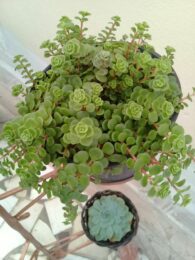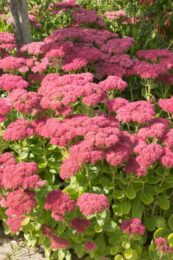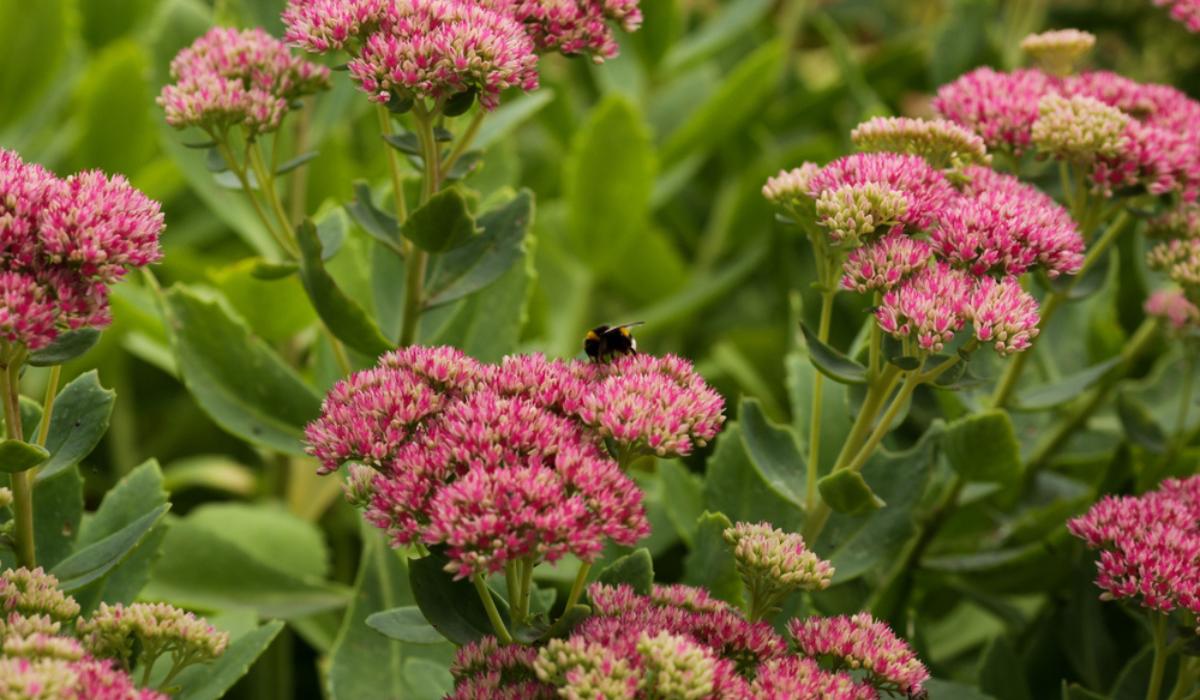The big flowering plant genus Sedum belongs to the Crassulaceae family, and its members are also referred to as stonecrops or orpines. The number of species in the genus was first estimated to reach 600 but has now been lowered to 400 to 500. These are leaf succulents that are mainly found in the northern hemisphere but also occur in Africa and South America. Sedum is the most common genus of Crassulaceae in temperate North America, with 400 species. Many sedum species include shrubs and plants. Sedum typically features cymose inflorescences and succulent leaves.

Source: Pinterest
Sedum: Quick facts
| Common Names | Sedum, stonecrop, showy stonecrop, border stonecrop |
| Botanical Name | Sedum spp |
| Family | Crassulaceae |
| Native Area | North America, South America, Central America, Europe, Asia, Africa, Mediterranean |
| Plant Type | Perennial |
| Mature Size | 6–24 inches tall, 12–24 inches wide |
| Sun Exposure | Full, partial |
| Soil Type | Sandy, loamy, well-drained |
| Flower Color | Red, pink, yellow, white |
| Bloom Time | Summer, fall |
Sedum: Physical description
The succulent leaves and stems of the genus’s perennial, biennial, or annual herbaceous plants serve as a distinctive feature. Green, yellow, red, blue, silver, or variegated leaves make up foliage. The little leaves are spiky or spherical. During the summer, blooms with a star shape bloom in shades of yellow, orange, pink, or white. Fruit is rarely capsule-shaped; it typically appears as a follicular cluster.
Sedum: How to grow?
Through division
Place the plant in the hole after you have dug it deep enough so that the top of the root ball is level with the soil’s surface. Then, backfill the area around the plant. Sedum that grows upright should not have the stems buried, as this might cause rot.
Through cuttings
Sedum is easily grown through cuttings, just like other succulents. Under the right lighting and watering conditions, the cutting should easily root if the cut end is simply inserted into the soil.
Set out the plants and gauge their spacing before you drill the holes (the plant tag will tell you how far apart they should go). Sedums that are shorter and more sprawling than those that are upright usually require more space.
- Once the spacing is ideal, excavate a hole that is slightly wider and deeper than the root ball.
- To give your sedum a promising start, drop a planting tablet into the bottom of the hole. Then, cover the tablet with a thin layer of soil.
- Combine the soil as directed.
- Set your sedum in the ground so that the top of the root ball is level with the surface.
- Water well.
Growing in containers
- Sedums grow well in containers. Start by selecting a pot that is no wider than the plastic bag that the sedum was packaged in.
- When planting in an area with a lot of rain, prefer unglazed clay or terra cotta containers over glazed pottery or plastic pots since they dry out more rapidly.
- Fast-draining cactus, palm & citrus potting mix should make up about 1/3 of the pot.
- Add a planting tablet, cover it with some soil, and then add more soil until it is about 3/4 inch below the rim (to prevent soil from washing out when you water the plants).
- Thoroughly rinse off. If the top 2 inches of soil feel dry, rewater. Bring the containers under a shade until drier weather returns if it’s raining a lot in your area.
- Lavender, oregano, rosemary, or spurge are a few examples of plants with similar water requirements that you may grow alongside sedum in a little larger pot with.

Source: Pinterest
Sedum: How to care?
Light
The majority of sedum plants thrive in full sun, which is defined as at least six hours of direct sunlight on most days. Even though they frequently won’t be as resilient or produce as many flowers as they would in full sun, certain varieties can endure some partial shade. Several sedum cultivars do benefit from some afternoon shade, though, especially in extremely hot and dry conditions.
Soil
Sedum often favours loamy, sandy, or gravelly soil with excellent drainage. Sedum can readily develop root rot when the soil holds too much water, as is frequently the case with heavy, damp clay soil.
Water
To keep the soil from drying up, water young sedum plants about once a week. Once established, sedum plants normally won’t require any additional watering unless there is a prolonged period of dry weather and/or extremely high temperatures. Sedum plants can withstand drought well because of their thick succulent leaves.
Temperature and humidity
Each sedum species has a different growing zone. Because extremely high temperatures (over 90 degrees Fahrenheit) might cause scorched leaves, these plants can generally withstand a wide range of temperatures. Sedum plants typically adapt well to dampness. To keep the plants from resting in too much moisture, however, good soil drainage is crucial in places with high humidity levels.
Fertiliser
Sedum normally doesn’t require additional fertilisation and can grow in nutrient-deficient soil. This can result in sluggish, lanky growth if the soil is very rich. If your soil is extremely poor, adding little compost will usually be sufficient to give your sedum a boost.
Pruning
Sedum doesn’t require a lot of trimming, just the removal of any damaged or diseased stems. In colder areas, it is beneficial to remove all the dead plant parts in the early spring to provide a place for new growth on sedums that die back in the winter.
Sedum: Uses
- Sedum is a blooming plant that has occasionally been used to make medicine.
- Although there isn’t yet any evidence to support these claims, they are thought to alleviate cough and lower blood pressure and can be applied to the skin to treat burns, cuts, haemorrhoids, and eczema.
- Sedum is most frequently and widely used to relieve inflammation and pain. Discovering its anti-inflammatory and anti-nociceptive mode of action is the focus of the current study.
- These plants are also thought to have diuretic and laxative effects. Ultimately, the most frequent applications are for treating warts, pimples, acne dermatitis, itchy rashes, ulcers, and other skin diseases.
- For their mildly astringent, sour flavour, the leaves and flowers of most Sedums are added to soup recipes, smoothies, and green salads.
- Yellow flowering sedums have minor toxicity and must be cooked, whereas the leaves, stems, and tubers of red flowering sedums can be consumed raw in salads.
Sedum: Toxicity
There are many different sedum species, but none of them is known to be toxic to people or animals.
FAQs
Where is the ideal place to plant sedum?
Sedums prefer direct sunlight but can tolerate light shade. Plant sedum in full sun to enhance overwintering potential if you live somewhere with long, cold winters. Although sedum thrives in sandy or poor soil, it needs to be well-drained to prevent fungal diseases.
What is the medicinal benefit of sedum?
Pain and inflammation are the two conditions for which sedum is most frequently used. The anti-inflammatory and anti-nociceptive mode of action of this plant is currently being studied.
| Got any questions or point of view on our article? We would love to hear from you. Write to our Editor-in-Chief Jhumur Ghosh at jhumur.ghosh1@housing.com |






